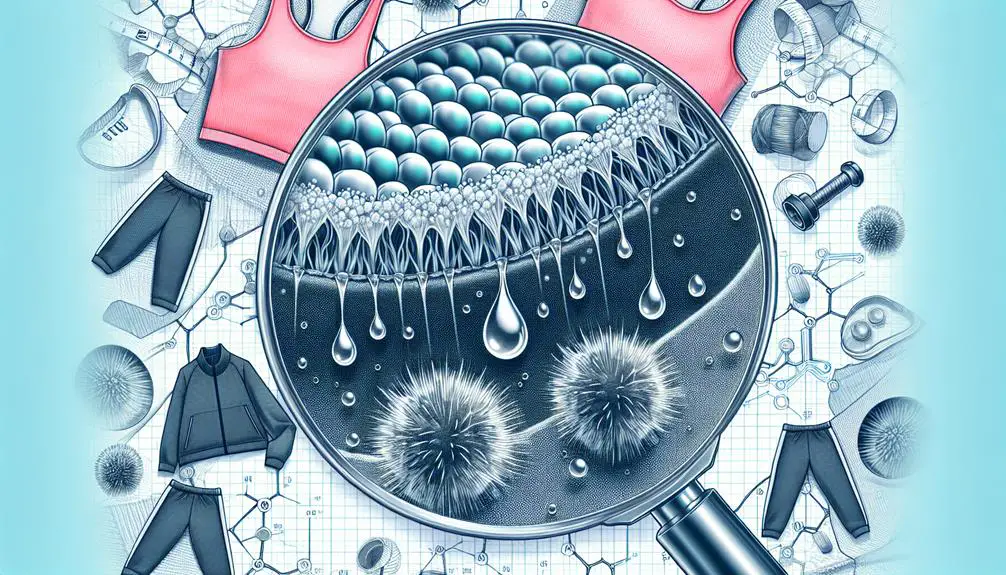Just as Prometheus brought fire to humanity, modern fabric technology brings unparalleled comfort and performance to your active lifestyle. When you think about moisture management, you're considering fabrics designed to whisk sweat away from your skin, ensuring you stay dry and comfortable. Whether you're drawn to the durability of polyester or the natural breathability of Merino wool, the options are vast and varied. But what really sets these fabrics apart? And how do innovations like hydrophobic treatments enhance their functionality? Let's explore the intricacies that make these materials indispensable for your wardrobe.
Table of Contents
Key Takeaways
- Synthetic fabrics like polyester and nylon provide excellent moisture-wicking capabilities by drawing sweat away from the skin.
- Dual-layer fabric designs enhance swift sweat removal and improve evaporation rates.
- Hydrophobic treatments create water-repellent, breathable fabrics ideal for activewear and outdoor gear.
- Innovations in fabric technology, such as nanotechnology and smart textiles, enhance moisture control and overall performance.
- Proper care and maintenance, including avoiding fabric softeners, extend the lifespan and effectiveness of moisture-wicking fabrics.
The Science of Sweat
Understanding how sweat is produced and managed by the body is essential for appreciating the role of moisture-wicking fabrics. When you exercise or face high temperatures, your body produces sweat to help regulate its temperature. Sweat composition primarily consists of water, along with small amounts of salts, proteins, and other trace elements.
Your sweat glands are activated, releasing this fluid onto the surface of your skin. The evaporation process is key here—sweat absorbs heat from your body as it shifts from liquid to vapor, effectively cooling you down. However, not all sweat evaporates immediately. If it sits on your skin too long, it can saturate your clothing, making you feel uncomfortable and clammy.
This is where moisture-wicking fabrics come into play. They're designed to facilitate the evaporation process by drawing sweat away from your skin to the surface of the fabric, where it can evaporate more efficiently. This process helps keep you dry and comfortable, even during intense physical activities.
Key Fabric Properties
What makes moisture-wicking textiles so effective at keeping you dry and comfortable during physical activities? The secret lies in their fabric structure and material characteristics. These textiles are crafted with specific weaves and fibers that enhance moisture absorption and promote heat dissipation.
First, let's examine fabric structure. Moisture-wicking textiles often feature a dual-layer design. The inner layer, closest to your skin, swiftly pulls sweat away from your body. The outer layer then disperses this moisture across a larger surface area, accelerating evaporation. This arrangement ensures you stay dry and prevents the stickiness that hinders performance.
Material properties also play a crucial role. Synthetic fibers like polyester and nylon are hydrophobic, meaning they repel water. This quality enables them to transfer moisture efficiently from the skin to the fabric's surface. Furthermore, these materials are lightweight and breathable, which assists in heat dissipation. By keeping you cool, they help maintain your body's ideal temperature during intense workouts.
In essence, it's the intricate combination of fabric structure and material characteristics that allows these modern textiles to excel at moisture management. Mastering this knowledge empowers you to choose the finest gear for peak performance.
Natural Vs. Synthetic
When choosing between natural and synthetic fabrics, you'll want to factor in aspects like breathability and comfort levels.
Think about how each type influences durability and maintenance, as well as their environmental impact.
Let's explore these key points to help you make an informed decision.
Breathability and Comfort Levels
Frequently, the choice between natural and synthetic fabrics hinges on how well they balance breathability and comfort. Natural fabrics like cotton and linen excel in fabric construction that facilitates moisture transport. Their fibers naturally wick away sweat, allowing your skin to breathe and maintain a comfortable temperature. This capability provides a superior comfort and performance balance, especially in hot and humid conditions.
On the other hand, synthetic fabrics such as polyester and nylon have been engineered to enhance these properties. Modern advancements in textile technology have led to the creation of microfibers and specialized weaves that notably improve moisture transport. These synthetics can match, and sometimes surpass, natural fabrics in breathability, offering you a high level of comfort during intense physical activities.
However, the ultimate choice depends on your specific needs. If you prioritize a natural feel and sustainability, natural fabrics are the go-to. But if advanced performance and moisture management are paramount, synthetic options might be more suitable.
Understanding the nuances of fabric construction and how they impact moisture transport is key to making an informed decision that aligns with your comfort and performance balance.
Durability and Maintenance
Over time, natural fabrics like cotton and linen tend to wear out faster and require more delicate care compared to their synthetic counterparts. You'll find that natural fibers often need specific care instructions to maintain their longevity. For instance, they might require gentle washing cycles, air drying, and ironing at low temperatures. This careful fabric maintenance guarantees you get the most out of these materials, but it doesn't change the fact that they generally don't last as long as synthetics.
On the other hand, synthetic fabrics such as polyester and nylon undergo rigorous durability testing to withstand harsh conditions. These materials are engineered to be resilient, often resisting wear and tear far better than natural fibers.
When it comes to care, synthetics are simple. They can usually handle higher temperatures in both washing and drying, which simplifies your laundry routine and adds to their longevity.
Environmental Impact Analysis
Although synthetic fabrics offer durability and ease of care, they come with significant environmental drawbacks. You've got to take into account the sustainability impact of both natural and synthetic fabrics. Synthetic materials like polyester and nylon are derived from petroleum, a non-renewable resource. Their manufacturing processes release harmful chemicals and greenhouse gases, contributing to pollution and climate change.
Conversely, natural fabrics like cotton and wool often have a lower environmental footprint. However, they aren't without their own concerns. Cotton farming requires substantial water and pesticides, while wool production impacts land use and methane emissions.
Here's a quick comparison:
| Aspect | Synthetic Fabrics | Natural Fabrics |
|---|---|---|
| Raw Material Source | Petroleum-based | Plant or animal-based |
| Manufacturing Processes | High energy, chemical-intensive | Lower energy, varied |
| Sustainability Impact | High pollution, non-renewable | Water use, land impact |
| End-of-Life | Non-biodegradable | Biodegradable, compostable |
You need to evaluate these factors when deciding on fabric choices. Synthetic fabrics might seem convenient, but their long-term environmental costs are substantial. On the other hand, natural fabrics, while generally more sustainable, still require mindful sourcing and consumption practices to truly minimize environmental harm.
Wicking Mechanisms
Understanding wicking mechanisms starts with capillary action, which moves moisture away from your skin.
Synthetic fibers excel at this, offering superior moisture management.
You'll experience enhanced comfort and dryness, making these fabrics ideal for activewear.
Capillary Action Explained
Capillary action, also known as wicking, allows modern fabrics to draw moisture away from your skin, keeping you dry and comfortable. This phenomenon relies on the fabric's ability to absorb and redistribute moisture through tiny capillaries or pores.
When you sweat, the water absorption process begins as the fabric pulls moisture into these microscopic channels. This action is essential to maintaining ideal fabric performance, especially in activewear and sports gear.
To understand how capillary action works, imagine placing a paper towel edge into a glass of water. The water climbs up the towel, defying gravity, because the fibers attract and pull the moisture up through capillary forces.
Similarly, high-performance fabrics like polyester and nylon are engineered with specialized structures that enhance this wicking capability. They create a continuous flow, moving sweat from the inner layer of the fabric to the outer surface, where it can evaporate more quickly.
Synthetic Fiber Benefits
High-efficiency fabrics like polyester and nylon not only excel at wicking moisture but also offer several benefits due to their synthetic nature. These fibers are designed to quickly transport sweat away from your skin, keeping you dry and comfortable during intense activities.
The performance advantages of synthetic fibers are evident in their durability, lightweight nature, and resistance to shrinkage and wrinkles.
You'll find that synthetic fabrics often come with sustainability benefits. Many manufacturers are now producing eco-friendly options by recycling polyester from plastic bottles, reducing waste and conserving resources. This shift towards more sustainable practices doesn't compromise the high wicking capabilities or the overall performance of the fabric.
When considering cost effectiveness, synthetic fibers stand out. They're generally more affordable than natural fibers and offer superior longevity, making them a wise investment for athletic and outdoor gear. The combination of moisture management, durability, and cost-effectiveness ensures you get the best value for your money.
Understanding these benefits allows you to make informed choices about your activewear. Whether you're an athlete, a hiker, or someone who values comfort and sustainability, synthetic fabrics offer a range of advantages that cater to your needs.
Breathability Factors
Breathability in modern fabrics hinges primarily on how effectively they allow air and moisture to pass through. When considering fabric breathability, you're looking at the performance of materials under various conditions. High breathability guarantees that sweat evaporates quickly, keeping you dry and comfortable, especially during intense activity levels. Effective moisture management is essential here; it dictates how well the fabric handles perspiration and maintains comfort.
Here's a simple table to visualize the breathability factors:
| Factor | Impact |
|---|---|
| Airflow | Enhances cooling and comfort |
| Moisture Wicking | Moves sweat away from the skin |
| Fabric Structure | Determines the rate of evaporation |
Airflow is crucial for cooling and comfort. Fabrics with good airflow let your body heat escape, preventing overheating. Moisture wicking is equally important; it transports sweat from the skin's surface to the fabric's outer layer, where it can evaporate. Lastly, the structure of the fabric—woven or knit—plays a significant role in evaporation rates and overall breathability.
Hydrophobic Treatments
When it comes to staying dry, hydrophobic treatments on fabrics ensure that water beads up and rolls off instead of soaking in. By incorporating advanced textile coatings, you can greatly enhance the performance of your garments, ensuring they offer superior water repellency. These fabric treatments create a protective barrier on the surface of the fibers, making them resistant to water penetration without compromising breathability.
To achieve this, manufacturers apply specialized coatings that bond at a molecular level with the fabric. This not only repels water but also enhances the longevity of the garment. You'll find that hydrophobic treatments are essential for activewear, outdoor gear, and even casual wear, where maintaining dryness is vital for comfort and performance.
Mastering the use of hydrophobic treatments means understanding the balance between water repellency and maintaining the fabric's original properties. It's not just about keeping water out; it's about doing so effectively without adding bulk or stiffness.
The key lies in the application process and the quality of the coatings used. As someone aiming for expertise, you should prioritize fabric treatments that offer long-lasting protection while retaining the fabric's natural feel and flexibility.
Popular Moisture-Wicking Fabrics
While hydrophobic treatments play an important role in water repellency, popular moisture-wicking fabrics like polyester, nylon, and merino wool focus on effectively drawing sweat away from your skin.
Choosing the right fabric is essential for peak performance, whether you're running a marathon or hiking a mountain. Polyester, often used in activewear, excels in its ability to wick moisture quickly and efficiently.
Nylon, another synthetic option, offers excellent durability and moisture management, making it a top choice for high-intensity activities.
Merino wool, a natural fiber, stands out by providing moisture-wicking properties along with temperature regulation. It's perfect for both summer and winter sports, ensuring you stay dry and comfortable.
Your fabric selection will significantly impact your performance, so understanding the qualities of each material is crucial.
Market trends show an increasing demand for advanced moisture-wicking fabrics as active lifestyles become more popular. Innovations in fabric technology continue to push the boundaries, offering superior comfort and functionality.
By staying informed about these trends, you can make educated choices that enhance your performance and meet the evolving needs of modern athletes.
Innovations in Fabric Technology
You'll find that modern advances in fabric technology are revolutionizing moisture management.
From advanced hydrophobic materials that repel water to smart textiles that adapt to your body's needs, these innovations are transforming your clothing experience.
Let's explore how these cutting-edge developments keep you dry and comfortable.
Advanced Hydrophobic Materials
Innovations in water-resistant materials are revolutionizing modern fabric technology by offering superior moisture resistance. You'll find that nanotechnology applications play a pivotal role in these advances. By manipulating materials at the molecular level, scientists have created fabrics that repel water with remarkable efficiency. Performance testing confirms that these materials not only prevent moisture absorption but also maintain their repellent properties under demanding conditions.
When it comes to water repellent coatings, the integration of advanced nanoparticles greatly enhances fabric performance. These coatings form a barrier that effectively blocks water penetration without compromising breathability. You'll appreciate how this innovation allows you to stay dry and comfortable, whether you're engaging in high-intensity sports or maneuvering through inclement weather.
Moreover, the ongoing development of these water-resistant materials means that they're becoming increasingly durable and versatile. Through rigorous performance testing, manufacturers guarantee that these fabrics can withstand repeated exposure to moisture and still function at their best. You'll notice that this makes them ideal for a wide range of applications, from outdoor gear to everyday clothing.
Smart Textiles Integration
Building on the advancements in moisture management, smart textiles are now integrating cutting-edge technology to enhance both functionality and user experience. You'll find that smart technology in fabrics is revolutionizing the way moisture is controlled, offering unprecedented performance and comfort.
Textile sensors embedded within the fabric actively monitor and respond to your body's moisture levels in real-time. These sensors can detect changes in humidity and temperature, allowing the fabric to adjust its properties for ideal moisture control.
Imagine wearing a shirt that knows when you're sweating and can regulate its breathability and moisture-wicking capabilities accordingly. This level of interaction between the fabric and your body is made possible through innovative designs that seamlessly blend technology with textiles.
Smart textiles aren't just about managing moisture; they also provide data that can be used to improve athletic performance, health monitoring, and even environmental conditions.
Choosing the Right Fabric
Choosing the correct fabric plays a pivotal role in achieving ideal moisture management. When you focus on fabric selection, you guarantee that your garments effectively manage moisture, keeping you comfortable and dry. Key factors in your selection process should include the fabric's ability to wick moisture away from the skin, its breathability, and its drying time. Each of these elements contributes to superior moisture control, making your choice not just about comfort, but also about performance and longevity.
To help you make an informed decision, consider the following attributes of popular moisture-wicking fabrics:
| Fabric Type | Moisture Wicking | Breathability |
|---|---|---|
| Polyester | High | Moderate |
| Nylon | High | High |
| Merino Wool | Moderate | High |
| Bamboo | Moderate | High |
Polyester is renowned for its excellent moisture-wicking properties but offers moderate breathability. Nylon, on the other hand, combines high moisture-wicking abilities with exceptional breathability. Merino wool, while offering moderate moisture control, excels in breathability and natural odor resistance. Bamboo fabrics provide a sustainable option with good moisture control and high breathability.
Care and Maintenance
Proper care and maintenance of your moisture-wicking fabrics extend their lifespan and guarantee they continue to perform effectively. To achieve fabric longevity and maintain their stain resistance, you need to adopt specific cleaning techniques.
Here's how you can secure your garments stay in top shape:
- Wash in Cold Water: Hot water can break down the fibers and diminish the fabric's ability to wick away moisture. Always opt for cold water to safeguard the material.
- Avoid Fabric Softeners: Fabric softeners can coat the fibers, reducing their stain resistance and moisture-wicking properties. Instead, use a mild detergent designed for performance fabrics.
- Air Dry: High heat from dryers can weaken the fabric structure, leading to reduced effectiveness. Hang your garments to air dry, preserving their integrity and functionality.
Frequently Asked Questions
How Does Moisture Management Affect Athletic Performance?
When you've got effective sweat absorption, you'll stay dry and comfortable, leading to performance enhancement. It prevents distractions and discomfort, allowing you to focus entirely on your athletic goals and achieve peak performance.
Are Moisture-Wicking Fabrics Environmentally Friendly?
Every rose has its thorn, and the sustainability impact of moisture-wicking fabrics is no exception. You should consider the manufacturing practices involved, as they often determine whether these fabrics are truly environmentally friendly or not.
Can Moisture-Wicking Fabrics Be Used in Everyday Clothing?
Yes, you can definitely use moisture-wicking fabrics in everyday wear. The benefits include comfort and quick drying, but drawbacks might be limited style options and potential environmental concerns. Choose wisely to maximize your wardrobe's versatility.
What Are Common Applications of Moisture-Wicking Fabrics Outside of Sports?
You won't believe where moisture-wicking fabrics are used today. Beyond sports, they've revolutionized medical garments, keeping patients dry and comfortable. Outdoor apparel also benefits, ensuring you stay dry during your most demanding adventures.
How Do Moisture-Wicking Fabrics Impact Skin Health?
Moisture-wicking fabrics enhance skin health by maintaining skin hydration and reducing irritation. Advanced fabric technology guarantees your skin stays dry, preventing conditions like rashes and infections, giving you confidence in your daily activities.
- What Is Gore-Tex Active? A Guide to the Lightweight Fabric - July 1, 2025
- What Is Gore-Tex Active? A Guide to the Lightweight Fabric - July 1, 2025
- What Is Gore-Tex Active? A Guide to the Lightweight Fabric - July 1, 2025







